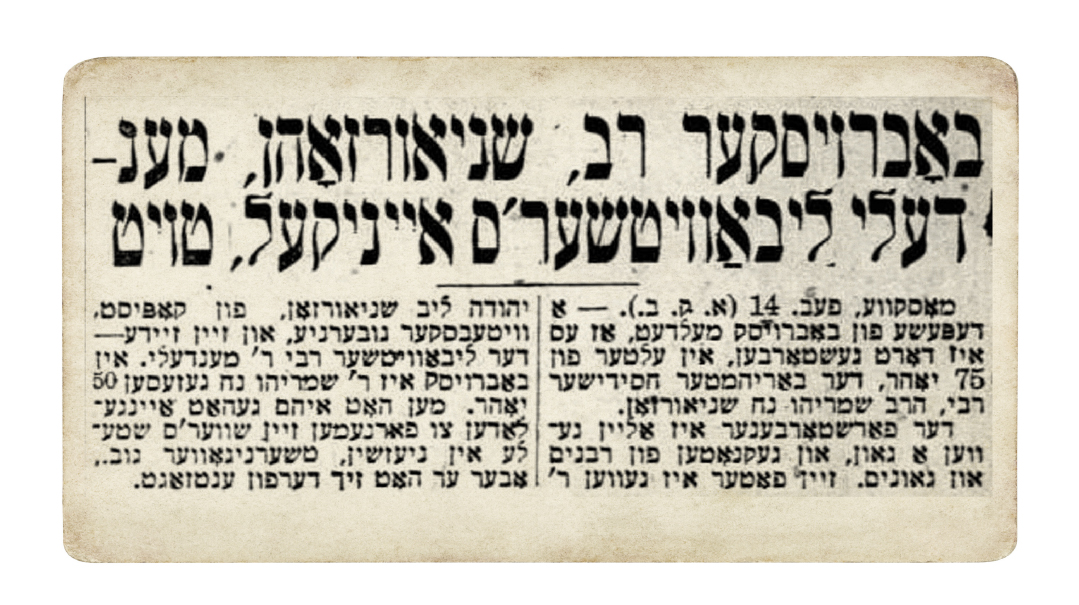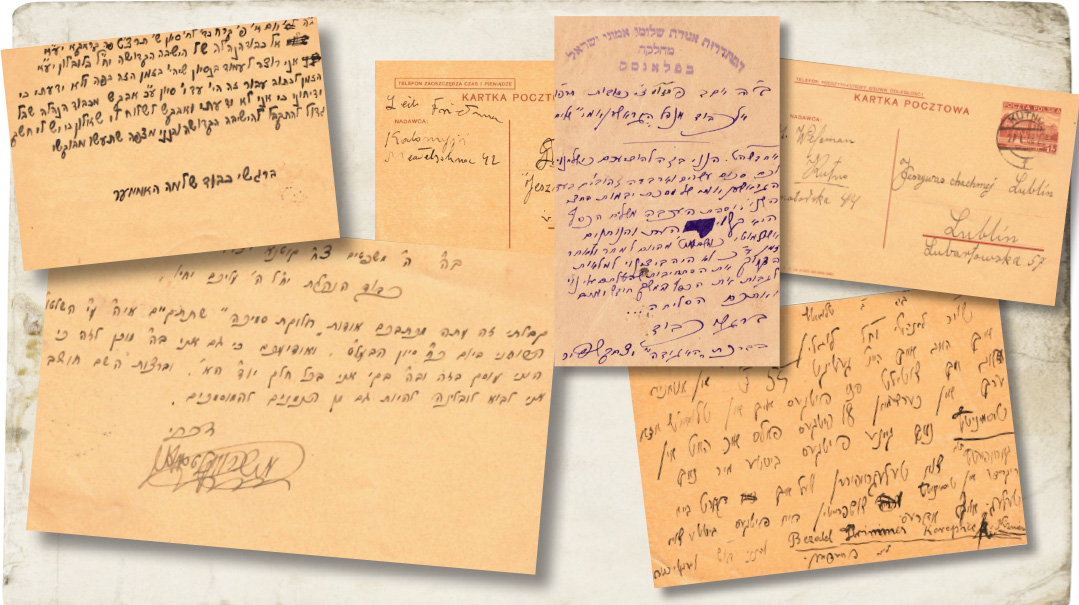Captain of Kapust
| December 26, 2023Rav Menachem Mendel Schneersohn (1789–1866), brought the town of Lubavitch to prominence as a center of Torah and chassidus

Title: Captain of Kapust
Location: Bobruisk, Russia
Document: Der Tog
Time: 1923
The Tzemach Tzedek, Rav Menachem Mendel Schneersohn (1789–1866), brought the town of Lubavitch to prominence as a center of Torah and chassidus over the nearly four decades of his leadership as the third Rebbe of Chabad. He was recognized across the Russian Empire as a respected tzaddik, rabbinical leader, and posek, undertaking efforts to alleviate the crushing economic burden on Jews in the Pale of Settlement and interceding with czarist government officials on matters of military service and other challenges. He also worked in tandem with other Torah leaders, such as Rav Itzele Volozhiner, to combat attempts at education reform.
Upon the Tzemach Tzedek’s passing on 13 Nissan 1866, he left behind six sons (as well as two daughters, and a son who predeceased him) who were sometimes referred to as “the six branches of the menorah.” The Chabad dynasty split into several branches, with the youngest, Rav Shmuel, the Maharash, succeeding his father in Lubavitch itself. The second-oldest son, Rav Yehuda Leib Schneersohn (1809–1866), settled in Kapust and assumed the role of Rebbe over what would become Chabad’s dominant branch in terms of both size and influence in the latter decades of the 19th century.
The Baal Hatanya, Rav Yehuda Leib’s great-grandfather, had served as his sandek. He would later become especially close to his grandfather, the Mittler Rebbe. Though Rav Yehuda Leib began to attract a significant following after becoming Rebbe in Kapust, he unfortunately passed away only a few months after his father. He was succeeded in turn by a trio of his sons.
The oldest, Rav Shlomo Zalman, remained in Kapust, where he led the Chabad community for 34 years. Among his followers were the famous Chabad chronicler Rav Chaim Meir Heilman, and the Rogatchover Gaon, Rav Yosef Rosen. The next brother, Rav Shalom Dovber, served as rav in Rechytsa until his passing in 1908; in addition to leading his chassidim, who included Rav Shlomo Yosef Zevin and Hillel Zeitlin, he was renowned as a posek.
The most influential leader of the Kapust dynasty was the youngest brother, Rav Shmaryahu Noach Schneersohn. In 1870 he was appointed rav of Bobruisk, a position he’d maintain until his passing in 1923. With over 20,000 Jews, it was one of the largest Jewish communities in the region. He also oversaw the activities of Kollel Chabad in Yerushalayim.
Rav Shmaryahu Noach established a yeshivah in Bobruisk in 1901. It quickly became one of the largest and most prestigious yeshivos in the entire region. The yeshivah flourished despite the travails of World War I, the Russian Revolution, and the establishment of the Soviet Union, only shutting down in the mid-1920s after his passing, in the face of draconian measures imposed by the Soviets on religious institutions. Rav Shmaryahu Noach was outspoken in opposing the rise of socialism and secularization on the Jewish street, and he did everything in his power to bolster traditional Judaism. He worked closely with many other rabbinical leaders across the spectrum of Chabad, chassidim, and members of the Lithuanian rabbinical establishment. He enjoyed an especially warm relationship with Rav Chaim Ozer Grodzenski.
He took an active role in the 1910 St. Petersburg rabbinical conference called by the czarist government in an attempt to regulate Jewish life in Russia. Among the contentious reforms of the rabbinate discussed at the conference were the idea that all rabbis should be required to have a formal general education, a position supported by the government as well as liberal members of the conference. The fifth Lubavitcher Rebbe, the Rashab, was among many vociferously opposed to any changes whatsoever in the traditional rabbinate.
Rav Shmaryahu Noach espoused the more moderate position that rabbis should have a basic knowledge of Russian as a prerequisite for their candidacy. He emphatically stated that he didn’t see anything detrimental about rabbis being somewhat proficient in the language of the land. This concurred with the views of Rav Chaim Ozer Grodzenski, Rav Itzele Ponevezher, the Ohr Sameach, and other prominent attendees.
Rav Shmaryahu Noach worked with Rav Chaim Ozer to try to establish the religious political party Knesses Yisrael, and following the February Revolution in 1917, he joined many others in Moscow to establish the short-lived Achdus Yisrael party. His close confidant, Rav Yehuda Leib Tzirelson, later emerged as one of the leaders of Agudas Yisrael.
With Rav Shmaryahu Noach’s passing in 1923, the harsh realities of religious life in the Soviet Union brought a unification of Chabad once again. Kapust and Lubavitch united under the leadership of Rav Yosef Yitzchak Schneersohn, the Rayatz.
Chabad Headquarters Everywhere
The other sons of the Tzemach Tzedek established courts across Russia. Rav Chaim Shneur Zalman returned to the Alter Rebbe’s town of Liadi, and Rav Yisrael Noach established his court in Nizhyn, which was the burial place of the Mittler Rebbe. Rav Yosef Yitzchak led chassidim in Ovruch, but he adopted the customs of his father-in-law, Rav Yaakov Yisrael Twersky of Cherkassy, and as a result his court had overtones of Chernobyl.
Last Laugh
At the passing of the Tzemach Tzedek, his oldest son, Rav Baruch Shalom Schneersohn, refused to become a rebbe and remained in Lubavitch. Nearly a century later, however, a great-great-grandson of Rav Baruch Shalom who was a namesake of the Tzemach Tzedek, Rav Menachem Mendel Schneerson, emerged as the seventh Lubavitcher Rebbe, one of the most dynamic and influential leaders in modern Jewish history.
(Originally featured in Mishpacha, Issue 992)
Oops! We could not locate your form.







